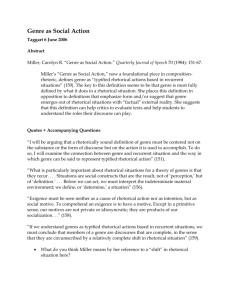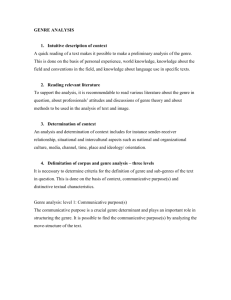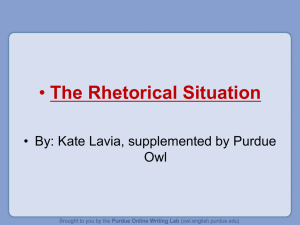Miller: definition of genre centred on the action it is used to accomplish
advertisement
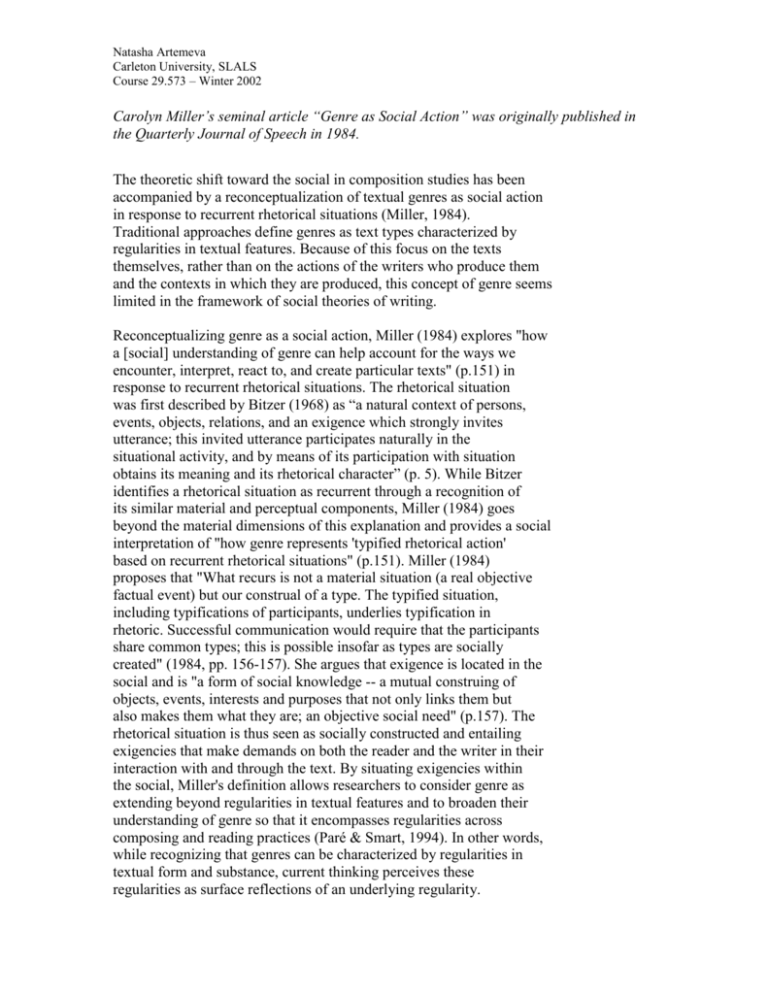
Natasha Artemeva Carleton University, SLALS Course 29.573 – Winter 2002 Carolyn Miller’s seminal article “Genre as Social Action” was originally published in the Quarterly Journal of Speech in 1984. The theoretic shift toward the social in composition studies has been accompanied by a reconceptualization of textual genres as social action in response to recurrent rhetorical situations (Miller, 1984). Traditional approaches define genres as text types characterized by regularities in textual features. Because of this focus on the texts themselves, rather than on the actions of the writers who produce them and the contexts in which they are produced, this concept of genre seems limited in the framework of social theories of writing. Reconceptualizing genre as a social action, Miller (1984) explores "how a [social] understanding of genre can help account for the ways we encounter, interpret, react to, and create particular texts" (p.151) in response to recurrent rhetorical situations. The rhetorical situation was first described by Bitzer (1968) as “a natural context of persons, events, objects, relations, and an exigence which strongly invites utterance; this invited utterance participates naturally in the situational activity, and by means of its participation with situation obtains its meaning and its rhetorical character” (p. 5). While Bitzer identifies a rhetorical situation as recurrent through a recognition of its similar material and perceptual components, Miller (1984) goes beyond the material dimensions of this explanation and provides a social interpretation of "how genre represents 'typified rhetorical action' based on recurrent rhetorical situations" (p.151). Miller (1984) proposes that "What recurs is not a material situation (a real objective factual event) but our construal of a type. The typified situation, including typifications of participants, underlies typification in rhetoric. Successful communication would require that the participants share common types; this is possible insofar as types are socially created" (1984, pp. 156-157). She argues that exigence is located in the social and is "a form of social knowledge -- a mutual construing of objects, events, interests and purposes that not only links them but also makes them what they are; an objective social need" (p.157). The rhetorical situation is thus seen as socially constructed and entailing exigencies that make demands on both the reader and the writer in their interaction with and through the text. By situating exigencies within the social, Miller's definition allows researchers to consider genre as extending beyond regularities in textual features and to broaden their understanding of genre so that it encompasses regularities across composing and reading practices (Paré & Smart, 1994). In other words, while recognizing that genres can be characterized by regularities in textual form and substance, current thinking perceives these regularities as surface reflections of an underlying regularity. Natasha Artemeva Carleton University, SLALS Course 29.573 – Winter 2002 The reconception of genre has also led to the changes in the focus of genre studies. Rather than concentrating primarily on literature, rhetorical studies of genre have focussed more on the social dynamics and social constitution of nonliterary forms of writing and speaking -the experimental article, reports by tax accountants, student writing in content areas, business memoranda, government proposals, etc. (e. g., Berkenkotter & Huckin, 1995; Freedman & Medway, 1994a; Paradis, Dobrin & Miller, 1995).
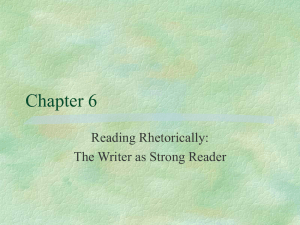
![Program`s Dynamic Criteria Map (DCM)[1]](http://s3.studylib.net/store/data/007112770_1-0a2faad44b8e94d6ea99c5f4cbf00e83-300x300.png)




